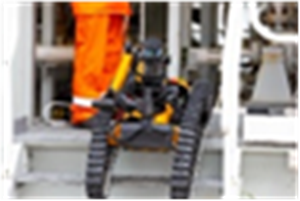Saving billions with bots
Although the digital transformation initiative was launched prior to the Covid-19 outbreak, the drive to adapt and implement new technology to increase efficiency and reduce costs is being accelerated by the pandemic. The combination of artificial intelligence, machine learning and the industrial internet of things is enabling remote operations and automation capabilities, leading to greater adoption and proliferation of intelligent oilfield operations. The ultimate goal is to use new systems and robot-type technologies to optimize performance and increase safety, while mitigating environmental impact.
Oilfield AI. Schlumberger has launched Agora, an open, secure and scalable AI platform specifically for the oil and gas industry. The company has developed a computing device that collects, integrates and transmits data from field devices to end-users. Each application, which is domain-specific workflows and algorithms, is deployed to the gateway to extract insights derived on location. The system has been used offshore Asia to enable remote visual analytics, to reduce HSE exposure and improve production surveillance and optimization. In India, the system was used to monitor the status of a rod pump and perform real-time analysis, to optimize production and mitigate damaging conditions. On U.S. land, an application provided real-time monitoring of well performance of multiphase flowmeters, providing insight to well behaviors to manage production and extend equipment run life. The system’s “intelligent internet of things” is intended to extract maximum value from existing assets, while delivering safer and more sustainable operations.
Green AI. Honeywell introduced an AI-enabled gas cloud imaging (GCI) system in Europe to provide automated and continuous monitoring for methane and other gas leaks at oil and gas, chemical and power generation facilities across the continent. The compact Mini GCI system is designed specifically for congested areas and small sites, which is ideal for European facilities. The GCI systems can be placed throughout an industrial facility to continuously monitor for gas leaks and provide alerts as soon as they occur. The GCI is powered by proprietary hyperspectral gas analytics, using artificial intelligence, and it provides facility operators with a colored visualization of the gas plume type, location, direction, size and concentration. The system’s continuous monitoring and real-time analytics allow for an earlier response before leaks have the chance to grow into bigger emissions or safety issues. The method is superior to current leak detection methods that require workers to periodically inspect a site with handheld thermal imaging cameras to identify leak sources and arrange for repairs. This approach is time-consuming, subject to human error, and can only detect a leak when the technician is in the field.
Unmanned aerial vehicle. ABB is producing an advanced drone-based leak detection and greenhouse gas measuring system called HoverGuard, to help U.S. operators inspect the 3 million mi of pipeline infrastructure to increase safety and comply with the U.S. 2020 PIPES Act. The UAV detects, quantifies and maps leaks up to 300 ft from natural gas distribution and transmission pipelines, gathering lines and storage facilities, quickly and reliably. It automatically generates comprehensive digital reports that summarize results and can be shared in minutes after a survey. The cloud-connected, multi-gas solution is also the first of its kind to quantify the three most important greenhouse gases—methane, carbon dioxide and water vapor—continuously while flying. Patented cavity-enhanced laser absorption spectroscopy detects methane, with a sensitivity more than 1,000 times higher than conventional leak detection tools. This sensitivity and speed allow the UAV to detect leaks while flying at altitudes of 130 ft and at speeds up to 55 mph. It can cover 10-15 times more land area per minute by operating on a low-cost commercial UAV. Previously, inspectors had to rely on slow, qualitative analog sensors or expensive cameras to find leaks. ABB’s solution effectively probes otherwise inaccessible locations to increase safety across the pipeline network.
Offshore inspection bot. Equinor plans to introduce autonomous robots to conduct routine inspection and maintenance tasks on their offshore oil and gas installations. The technology is produced by Austria-based robotics specialist Taurob, Fig. 1. In 2019, Equinor joined with Total, OGTC and Taurob in the ARGOS Joint Industry Project to develop a new robot capable of performing autonomous manipulation operations. The intent is to design a robust and reliable robot, with a yearly maintenance interval, ideal for normally unmanned facilities where human intervention is rare. The “work-class” robot will physically interact with the installation. Field testing will be performed later this year.
Bots could save billions. As documented above, operators are seeking to develop and implement new technologies to reduce costs and bolster against future market fluctuations. A report by Rystad Energy suggests that the adoption of existing robotic solutions could reduce drilling labor costs significantly by 2030, if there is an industry push for the transition. Applying supplier specifications, it’s estimated that robotic drilling systems could decrease the number of rig personnel by 20% to 30%. This reduction, in land and offshore drilling crews, could lower payroll costs by $7 billion in the U.S., alone. At least 20% of the jobs in drilling, operational support and maintenance could be automated in the next 10 years. Using current staffing levels, workforce reductions could total 140,000 in the U.S. and 200,000 in Russia. Canada, the UK and Norway could shed between 20,000 and 30,000 jobs, each.
The emergence of robotics in our industry is inevitable. However, the challenge of full-scale robotic adoption hinges on long-term reliability and communication capabilities in complex 3D environments, especially on offshore platforms. If robots are to fully replace humans, it’s imperative that these systems communicate seamlessly to unlock their full potential value. The implementation of such communication systems will be complex and costly. In addition, labor organizations will likely fight further automation and use of robotics, which may be subject to tests, to ensure they meet federal safety and environmental standards, Rystad concluded.




